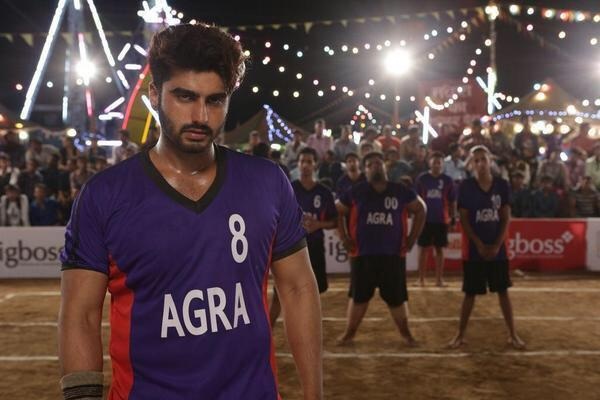Today's Mumbai Mirror column:
It's an unapologetically entertaining battle between good men and bad
men. But if one looks closely, underlying Tevar's masaledar heroics
is a fairly meaty take on masculinity.
In
recent years, the Hindi action movie has grown bigger, brasher, more
and more full of special effects, and less and less fun to watch.
When Akshay Kumar or Ajay Devgn or Salman Khan are doing the
pummelling, the only people likely to experience any surprise at
their being flattened into chappatis are the baddies themselves.
Because we’re dealing with Supermen, and everyone knows it.
Pintu
Shukla, in contrast, may get ‘Main hoon Superman, Salman ka fan’
as his ‘introduction song’, but he's no local legend. Or not yet.
The hero of Amit Ravindernath Sharma's directorial debut is Agra's
budding kabaddi champ, a local lafanga with a gender-sensitive heart.
Of
course, Pintu, being Arjun Kapoor, is anything but pint-sized, and
his opening one-man victory for the Kanpur kabaddi team has already
showcased large reserves of strength and endurance. But something
about Kapoor's energy makes Tevar's action scenes more enjoyable than
any I've seen in a while. He captures the youthful swagger of the
small town hero, in the sense of “bada hero banta hai”.
There's
little by way of plot or character that could be considered new in
Tevar. The small town boy's half-bored defiance of his middle class
parents is something we've seen, for example, in Bunty Aur Babli (the
father is even played by the same actor, Raj Babbar); the villainous
politician casting a covetous eye upon a local middle class girl,
too, has a long cinematic lineage — most memorably Haasil; the
recreation of the UP-Bihar milieu of generalised thuggery, where
corrupt cops and political goondas combine to throttle the faintest
voice of resistance, has been a dominant current for more than a
decade, including films like Shool and much of Prakash Jha's oeuvre. Stylistically,
too, Tevar is an out-and-out masala film. It feels at least 20
minutes too long because it really doesn't skimp on the set-pieces:
fights, songs, full-on dialoguebaazi.
I
haven’t seen Okkadu, the 2003 Telugu hit from which Tevar is
adapted, but director Amit Sharma (an advertising man best known for
the Google reunion tearjerker) clearly has a sound grasp of his
chosen North Indian milieu. He and Shantanu Srivastava, who shares
Tevar's writing credits with Okkadu's writer-director Gunashekhara,
have successfully transposed the script from its original Hyderabadi
setting to a Mathura-Agra world that feels vibrant and alive, even
while painted in broad, colourful, filmi strokes.
The
song choreographies and fight scenes offer a satisfying tour through
the grubby gullies and open terraces of the UP small town, with
well-timed local colour provided by steaming istris, hot halwais’
ladles and even a tashtri full of gulaal. The opening kabaddi match
between Mathura and Agra is also wonderfully imagined and nicely
paced: the semi-comic display of local sporting talent spliced
together with more lethal forms of political gamesmanship.
The
dialogue has enough local flavour to make even predictable scenes
juicy: “Jalwe toh nachaniyon ke hote hain,” drawls Manoj
Bajpayee's menacing Gajendar Singh as he eliminates a rival; an
anxious teammate waiting for our hero to arrive for the match,
erupts: “'Aa jayega, aa jayega': kya Karan Arjun hai jo aa jayega?”
But
what helped sustain my interest was the film's framing theme:
masculinity. Spoken or unspoken, violent or couched in humour, there
is no getting away from the film's central underlying question: what
does it take to be a man in a society as lawless and violent as this
one?
The
answer the film offers is no different from a million Westerns and
thousands of Hindi movies with even more invincible heroes: it takes
brute force. This is a world in which the sharp-tongued truth-seeking
journalist, for all the power of the media at his back, is easily
silenced by violent intimidation; the state is run by thugs, and the
police, even those members of it not in their pay, are emasculated by
the deep rot in the system.
So
what's left? Well, good louts versus bad louts. The street is, in
Tevar, the domain of men. And I say this not to criticise the film,
but to note the degree of attention it gives to what is after all, a
plain and simple fact about North India, but one that doesn't get any
play in most films set in the region. Here, there's an effectively
menacing scene involving a phone booth and a pichkari filled with
Holi colour; there's a lascivious driver at a traffic light. What is
unusual about Tevar is that it makes a point to underline the
non-stop harassment and lasciviousness that women face, without
necessarily turning all of it into life-threatening violence.
The
film's division between good masculinity and bad is built almost
wholly on the edifice of respect for women. Pintu's heroicness is
established early on by his playful rescuing of a cycling young woman
from the leering attentions of a local ruffian—and all through the
film's main rescue (that of Sonakshi Sinha's Radhika), he never once
makes unsolicited advances. If you're female, though, you can be
spirited and sardonic all you want, but in the end you're dependent
on good brute force to rescue you from the bad. And when it does, you
fall gratefully in love with it.
In
a world where the cinematic POV offered to us is so often that of the
man who takes the woman's reciprocation as his right (think
Raanjhana, Ek Deewana Tha, and a million others), Tevar's model for
masculinity is a huge advance. And for all their rambunctious
filminess, the streets of Tevar's universe aren't quite a figment of
the imagination. Hopefully some day, we'll have one in which men
don't have to beat up other men, and women can be something more than
grateful.

No comments:
Post a Comment